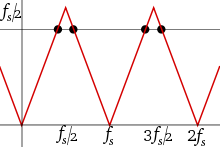- Nyquist frequency
-
Not to be confused with Nyquist rate.
 Frequencies above ƒs/2 (the Nyquist frequency) have an alias below ƒs/2, whose value is given by this graph. ƒs/2 is also called folding frequency, because of the symmetry between 0 and ƒs.
Frequencies above ƒs/2 (the Nyquist frequency) have an alias below ƒs/2, whose value is given by this graph. ƒs/2 is also called folding frequency, because of the symmetry between 0 and ƒs.
The Nyquist frequency, named after the Swedish-American engineer Harry Nyquist or the Nyquist–Shannon sampling theorem, is half the sampling frequency of a discrete signal processing system.[1][2] It is sometimes known as the folding frequency of a sampling system.[3]
The sampling theorem shows that aliasing can be avoided if the Nyquist frequency is greater than the bandwidth, or maximum component frequency, of the signal being sampled.
The Nyquist frequency should not be confused with the Nyquist rate, which is the lower bound of the sampling frequency that satisfies the Nyquist sampling criterion for a given signal or family of signals. This lower bound is twice the bandwidth or maximum component frequency of the signal. Nyquist rate, as commonly used with respect to sampling, is a property of a continuous-time signal, not of a system, whereas Nyquist frequency is a property of a discrete-time system, not of a signal. While the domain of the signals is commonly time, leading to a Nyquist frequency in Hertz, this does not have to be the case; for example, an image sampling system has a Nyquist frequency expressed in units of reciprocal length, such as cycles per meter.
Contents
The aliasing problem
In theory, a Nyquist frequency just larger than the signal bandwidth is sufficient to allow perfect reconstruction of the signal from the samples: see Sampling theorem: Critical frequency. However, this reconstruction requires an ideal filter that passes some frequencies unchanged while suppressing all others completely (commonly called a brick-wall filter). In practice, perfect reconstruction is unattainable. Some amount of aliasing is unavoidable.
Signal frequencies higher than the Nyquist frequency will encounter a "folding" about the Nyquist frequency, back into lower frequencies. For example, if the sample rate is 20 kHz, the Nyquist frequency is 10 kHz, and an 11 kHz signal will fold, or alias, to 9 kHz. However, a 9 kHz signal can also fold up to 11 kHz in that case if the reconstruction filter is not adequate. Both types of aliasing can be important.
When attainable filters are used, some degree of oversampling is necessary to accommodate the practical constraints on anti-aliasing filters: instead of a brickwall, one has flat response in the passband up to a point called the cutoff frequency or corner frequency, (pass all frequencies below there unchanged), then gradual rolloff in a transition band, finally suppressing signals above a certain point completely or almost completely in the stopband. Thus, frequencies close to the Nyquist frequency may be distorted in the sampling and reconstruction process, so the bandwidth should be kept below the Nyquist frequency by some margin (frequency headroom) that depends on the actual filters used.
For example, audio CDs have a sampling frequency of 44100 Hz. The Nyquist frequency is therefore 22050 Hz, which is an upper bound on the highest frequency the data can unambiguously represent. If the chosen anti-aliasing filter (a low-pass filter in this case) has a transition band of 2000 Hz, then the cut-off frequency should be no higher than 20050 Hz to yield a signal with negligible power at frequencies of 22050 Hz and greater.
Other meanings
Early uses of the term Nyquist frequency, such as those cited above, are all consistent with the definition presented in this article. Some later publications, including some respectable textbooks, call twice the signal bandwidth (the Nyquist rate) as Nyquist frequency;[4][5] this is a distinctly minority usage.
References
- ^ Grenander, Ulf (1959). Probability and Statistics: The Harald Cramér Volume. Wiley. http://books.google.com/books?id=UPc0AAAAMAAJ&q=%22nyquist+frequency%22+date:0-1965&dq=%22nyquist+frequency%22+date:0-1965&pgis=1. "The Nyquist frequency is that frequency whose period is two sampling intervals."
- ^ Harry L. Stiltz (1961). Aerospace Telemetry. Prentice-Hall. http://books.google.com/books?id=cro8AAAAIAAJ&q=%22nyquist+frequency%22+date:0-1965&dq=%22nyquist+frequency%22+date:0-1965&pgis=1. "the existence of power in the continuous signal spectrum at frequencies higher than the Nyquist frequency is the cause of aliasing error"
- ^ "An Introduction to Sampling Theory". http://www2.egr.uh.edu/~glover/applets/Sampling/Sampling.html. Retrieved 17 April 2010. "Frequencies "fold" around half the sampling frequency - which is why [the Nyquist] frequency is often referred to as the folding frequency."
- ^ Jonathan M. Blackledge (2003). Digital Signal Processing: Mathematical and Computational Methods, Software Development and Applications. Horwood Publishing. ISBN 1898563489. http://books.google.com/books?id=G_2Zh7ldQIIC&pg=PA93&dq=intitle:digital+intitle:signal+intitle:processing+nyquist-frequency.
- ^ Paulo Sergio Ramirez Diniz, Eduardo A. B. Da Silva, Sergio L. Netto (2002). Digital Signal Processing: System Analysis and Design. Cambridge University Press. ISBN 0521781752. http://books.google.com/books?id=L9ENNEPbZ8IC&pg=PA24&dq=intitle:digital+intitle:signal+intitle:processing+bandwidth+nyquist-frequency.
See also
- Nyquist rate
- Kell factor
- Sampling frequency
- Superoscillation
- Signal
Digital signal processing Theory Sub-fields Techniques Discrete Fourier transform (DFT) · Discrete-time Fourier transform (DTFT) · Impulse invariance · bilinear transform · pole–zero mapping · Z-transform · advanced Z-transformSampling oversampling · undersampling · downsampling · upsampling · aliasing · anti-aliasing filter · sampling rate · Nyquist rate/frequencyCategories:
Wikimedia Foundation. 2010.
